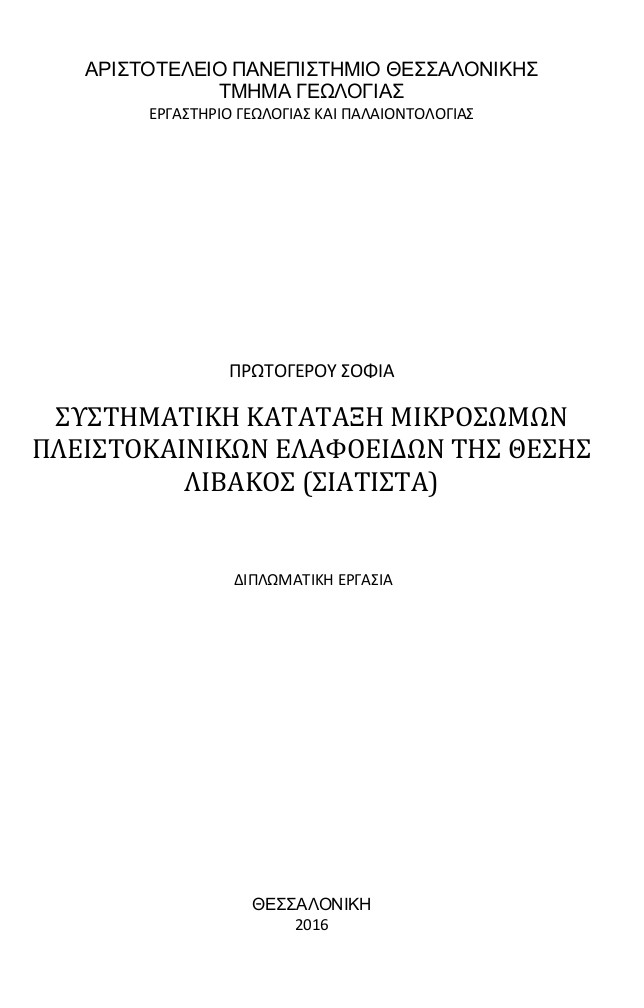
Συστηματική κατάταξη μικρόσωμων πλειστοκαινικών ελαφοειδών της θέσης Λίβακος (Σιάτιστα)
Περίληψη
Λέξεις κλειδιά: Πλειστόκαινο, Dama, συστηματική, ταξινόμηση, εξέλιξη
In summary, the present study presents the evolution of small-sized deer of the Pleistocene, specifically Villafrancian, from Europe, and comparing them with the antlers and lower mandible fossils from Livakos fossil site (W. Macedonia).Τhe aim of the study is to attribute these fossils in one of the known Pleistocenic species. The ancestors of fallow deer are located at the U. Pliocene and they are characterized by primitive dentition and very simple antler morphology in contrast to the complex and remarkably palmated antlers of the fallow deer. The taxonomy was based on the morphological characters of the antlers and the lower dentition, which along with the measurements from the sample of Livakos led to more accurate and detailed comparison.
Πλήρες Κείμενο:
PDFΑναφορές
Azzaroli A. 1947 ,1947,I Cervi fossili della Toscana con particolare riguardo alle specie vilafranchiane, Palaeontographica Italica,43,45-82
Azzaroli A., 1992. The cervid genus Pseudodama n.g. in the Villafrancian of Tuscany. Palaeontographica Italica,79 , 1-37.
Breda M., Lister A. M., 2013. Dama roberti, a new species of deer from the early Middle Pleistocene of Europe, and the origins of modern fallow deer, Quaternary Science Reviews, 69, 155-167
Croitor R., 2006. Early small-sized deer of Europe,Hellenic Journal of Geosciences,41,89-117
Croitor R., 2007. Evolution, ecology and biochronology of herbivore associations in Europe during the last 3 million years, Quaternaire, 18(2), 129-152.
Croitor R., 2014. Deer from Late Miocene to Pleistocene of Western Palearctic: matching fossil record and molecular phylogeny data,Zitteliana B,32,115-153
De Lumley,H. Kahlke,H.-D. Moigne, A.M. Moulle,P.E., 1988,Les faunes des Grands Mammiferes de la grotte du Vallonet,Roquebrune-cap-Martin, Alpes-Mari-times. L’Anthropologie 92(2),465-496.
De Vos, J. Mol, D. Reumer, J.W.F,1995, Early Pleistocene Cervidae(Mammalia, Artiodactyla) from Oosterschelde (the Netherlands), with a revision of the of the cervid genus Eucladoceros Falconer,1868.Deinsea,2,95-121.
Di Stefano G., Petronio C, 1998. Origin of and relationships among the Dama-like cervids in Europe,N. Jb. Geol. Palaont. Abh., 203,357-75
Di Stefano G., Petronio C. 2000-2002. Systematics and evolution of the Eurasian Plio-Pleistocene tribe Cervini (Artiodactyla, Mammalia),Geologica Romana,36,311-334.
Petronio C. ,Bellucci L. and Di Stefano G., 2013. Axis eurygonos from Pirro Nord (Aprocena, Southern Italy),Palaeontographica, Abt. B:Palaezoology-Stratigraphy,298,169-181
Pfeiffer Th, 1999, Di Stellung von Dama (Cervidae,Mammalia) im System plesiometacarpaler Hirsche des Pleistozans-Phylogenetische Rekonstruktion-Metrische Analyse,Courier Forschungsinstitut Senckenberg,211,1-218
Pfeiffer Th., 2005. The position of Dama (Cervidae, Mammalia) in the system of fossil and living deer from Europe-Phylogenetical analysis based on the postcranial skeleton,Les ongules Holartiques,39-57.
Μουντράκης, Δ., Μ., 2010. Γεωλογία και Γεωτεκτονική Εξέλιξη της Ελλάδας. University Studio Press, Θεσσαλονίκη.
Διαδικτυακές πηγές
http://photodentro.edu.gr/photodentro/gbg08_geolog_hellas_pidx0014899/
http://www.ime.gr/chronos/01/gr/intro/pleistokaino.html
http://users.uoa.gr/~alegakis/index_el_files/PDFfiles/Panida%20Elladas2010.pdf
http://greek-weather.org/viewtopic.php?t=2268
https://el.wikiversity.org/wiki/%CE%A4%CE%BF_%CF%86%CF%85%CF%83%CE%B9%CE%BA%CF%8C_%CF%80%CE%BB%CE%B1%CE%AF%CF%83%CE%B9%CE%BF_%CE%BA%CE%B1%CE%B9_%CE%B7_%CE%B5%CE%BC%CF%86%CE%AC%CE%BD%CE%B9%CF%83%CE%B7_%CF%84%CE%BF%CF%85_%CE%B1%CE%BD%CE%B8%CF%81%CF%8E%CF%80%CE%BF%CF%85
https://eclass.upatras.gr/modules/document/file.php/GEO324/%CE%93%CE%B5%CF%89%CE%BB%CE%BF%CE%B3%CE%AF%CE%B1%20%CE%95%CE%BB%CE%BB%CE%AC%CE%B4%CE%BF%CF%82/Internal%20Zones_Mesohellenic%2054-73.pdf
Εισερχόμενη Αναφορά
- Δεν υπάρχουν προς το παρόν εισερχόμενες αναφορές.
